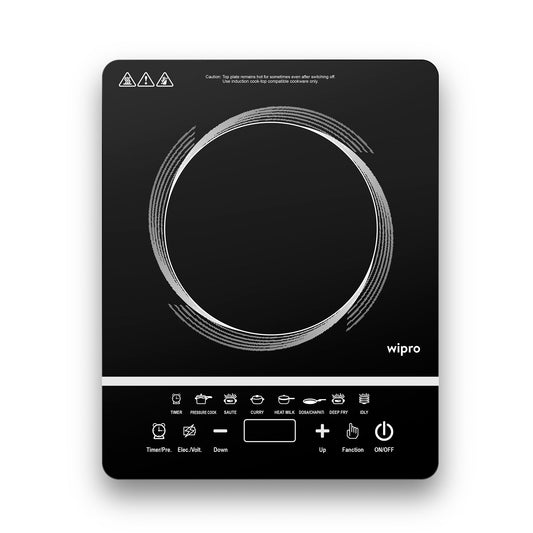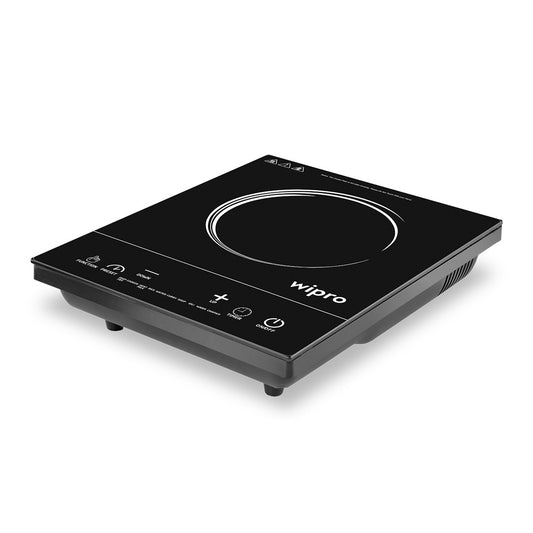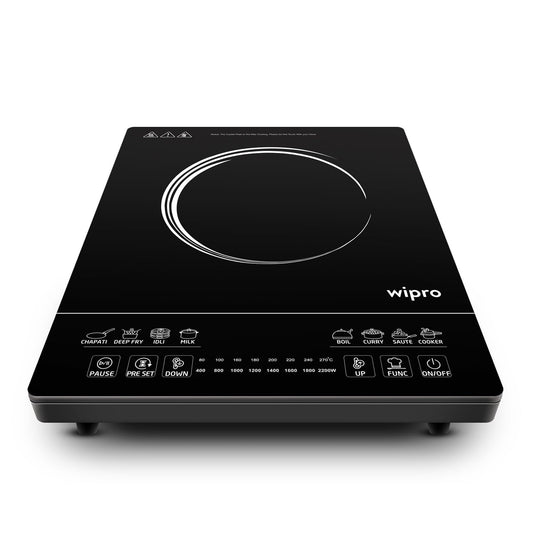Induction cooktops have revolutionized modern cooking with their blend of speed, precision, and efficiency. In an era when energy use and sustainability matter more than ever, understanding the power consumption of induction cooktops is essential for homeowners and environmental advocates alike. In this blog, we’ll explore how induction cooking works, what factors influence efficiency, and why it outperforms traditional methods. Stick around until the end to glimpse an excellent option: the Wipro Induction Cooktop, complete with features that enhance both performance and style.
Working of Induction Cooktop
An induction cooktop uses electromagnetic fields to heat cookware directly, rather than relying on an open flame or electric coils. When you turn it on, the magnetic field generates heat right in your pan, almost no energy is wasted heating the cooktop itself.
This translates to more efficient cooking, better control, and lower wasted energy. That’s why the induction stove power consumption is often substantially less than that of traditional stoves, and why it’s gaining attention as a go-to cooking option.
How Efficient Are Induction Cooktops?
Induction cooking shines when it comes to efficiency. About 85–90% of the energy is transferred right into your pot or pan, whereas gas stoves reach only around 40%, and electric coil stoves about 60%.
This heightened energy transfer means less heat loss, reduced cooking times, and a cooler kitchen environment, boosting the sustainability of daily cooking with noticeable reductions in electric consumption of induction cookers.
Power Consumption Insights:
You’ll typically see induction cooktops rated between 1200W and 2100W. A standard 2000W model uses approximately 2 kWh of electricity per hour on full power. However, the actual induction cooker electricity usage is lower in most meals.
Let’s break it down:
-
Full-power cooking for 15–20 minutes: approx. 0.5–0.7 kWh
-
Simmering or lower-heat cooking for another 20 minutes: perhaps 0.3–0.5 kWh
-
Result? A typical meal consumes just 1–1.5 kWh, making it both quick and economical.
Factors That Affect Electricity Usage:
Electric consumption of induction stoves and cookers may vary depending on:
-
Wattage Setting: Higher power delivers faster results but uses more juice. Smart use of medium or low ensures better efficiency.
-
Cooking Style: Rapid boils followed by lower heat levels, like simmering rice or curry, reduce energy use significantly.
-
Cookware Compatibility: Only magnetic cookware works on induction. Flat, well-fitting pans maximize heat transfer, minimizing loss.
-
Built-in Smart Features: Precision temperature controls, timers, and auto-shutoff save energy by preventing excess usage.
-
Kitchen Habits: Prepping ingredients in advance, using lids, and routine cleaning keep your induction stove operating at peak performance.
Comparing Induction Electricity Use:
|
Cooking Method |
Heat Efficiency |
Speed |
Safety |
Energy Use |
|
Gas Stove |
~40% |
Medium |
Moderate |
High (energy wasted) |
|
Electric Coil Stove |
~60% |
Slower |
Low |
Medium |
|
Induction Cooktop |
~85–90% |
Very Fast |
High |
Low to Medium (best use-case) |
When you look at overall power consumption of an induction cooktop, cooking times and energy input make induction the winner in energy-conscious kitchens.
Benefits Beyond Energy Savings:
-
Speed & Precision: Reaches target temperatures fast. Keeps simmer steady without supervision.
-
Safety: No open flame. Surface cools down quickly once cookware is lifted.
-
Cleanliness: Smooth glass surfaces make spills easy to wipe up.
-
Environmental Impact: Uses electricity cleanly, especially when the grid includes renewable sources.
All of this highlights why induction stove power consumption is only part of the story. The real payoff includes convenience, safety, and environmental stewardship.
Tips to Minimize Electricity Use:
You can enhance efficiency and cut down induction cooker electricity usage even more:
-
Use lids to reduce cooking time and heat loss.
-
Match cookware size to the heating zone.
-
Pre-measure ingredients before starting.
-
Use mid-heat settings instead of full power.
-
Take advantage of pre-set functions and smart sensors.
-
Keep the cooktop plate clean for optimal heat transfer.
Why Wipro Induction Cooktop is a Smart Energy-Saving Choice for Your Kitchen:
Looking for a balance of efficiency, performance, and style? The Wipro Induction Cooktop is a smart pick.
Key Highlights:
-
Smart Sensor Touch Control: Sleek and user-friendly interface.
-
Crystal Glass Plate: Cushions your kitchen with elegance and eases cleaning.
-
2000W Power Output: Fast cooking with up to 4× energy savings over conventional methods.
-
Precision Temperature Control: Fine-tune heat for every recipe.
-
Seven Indian Presets: Ideal for your favourite curries, rice dishes, and more.
-
Corded Electric Power Source: Delivers consistent output.
-
Glass Material: Durable and visually appealing.
This model maximizes the advantages of induction cooking, fast heating, smart controls, and cleanliness, while keeping electricity usage low.
Induction cooktops stand out as an energy-efficient, fast, and safe alternative to traditional stoves. Their superior energy transfer and smart features ensure reduced power consumption of induction cooktops, making them ideal for anyone mindful of energy use or cooking speed.
If you’re ready to upgrade your kitchen without upgrading your electricity bills, the Wipro Induction Cooktop delivers on speed, savings, and sleekness, bringing modern efficiency to the heart of every home.

































































































































































































































































































































































































































































































































